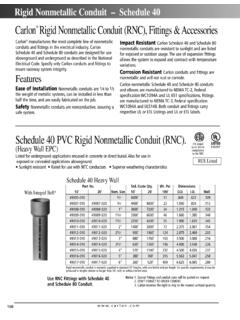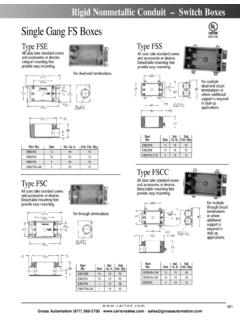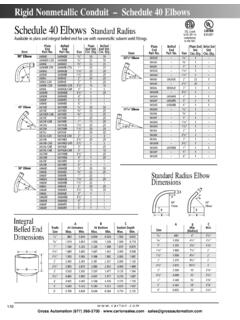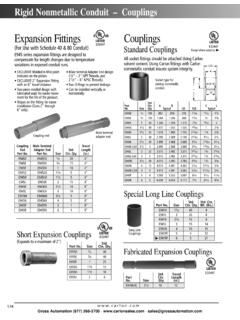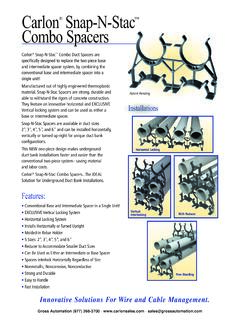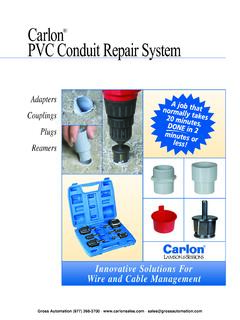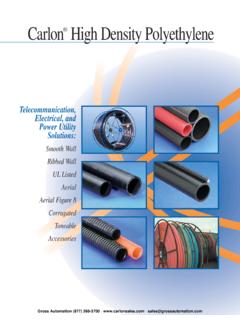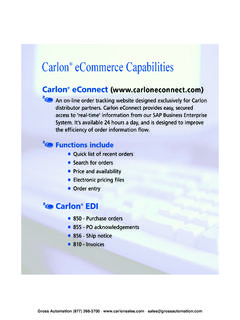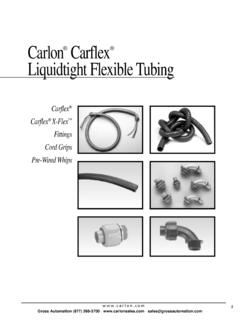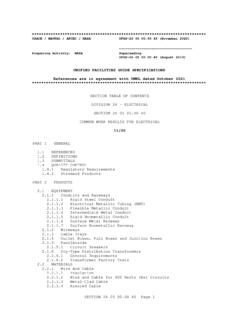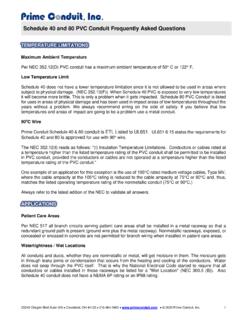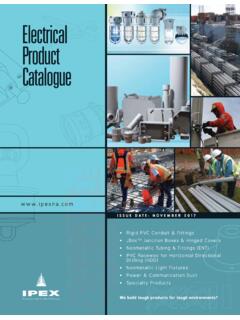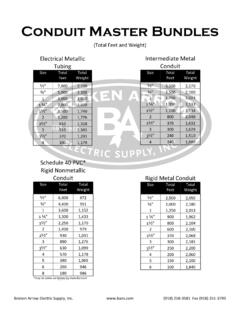Transcription of Expansion Joints for PVC Rigid Nonmetallic Conduit
1 Expansion Joints for PVC Rigid NonmetallicConduitAll construction materials expand and contract with fluctuations in temperature. These temperaturechanges affect polyvinyl chloride (PVC) more than traditional materials such as aluminum and steel. Forexample, the coefficient of thermal Expansion for PVC( x F) is almost three times as high asfor aluminum and six times as high as for Expansion and contraction have a significanteffect on long straight runs of Conduit . For this application, Expansion Joints are used to accommodate changes in length. This prevents potentiallyharmful thermal stresses in the Conduit itself or in any supporting Fittings RequiredSection 347-9 of the National Electric Code requires that Expansion Joints be installed for Rigid Nonmetallic Conduit to compensate for thermal Expansion and contraction where the length changeis anticipated to be in. ( ) or greater, in accordance with Table 347-9 of the 1999 NEC, ina straight run between securely mounted items.
2 Securely mounted items are boxes, cabinets, elbows,or other Conduit are Expansion Joints used?The importance of knowing when to use an Expansion joint is as important as knowing how to usean Expansion joint. Expansion Joints are used in aboveground installations where temperaturechanges are anticipated to exceed 25 F (14 C). Expansion Joints are usually used where thestraight run length is greater than 25 feet andexpected temperature change is greater than60 F. Rigid PVC Conduit has a coefficient ofexpansion of x F. A 10 footlength will change in length about 3/8" with achange in temperature of 100 F. This equatesto more than 4 inches over a 100 foot Automation (877) 268-3700 are Expansion Joints used? (continued)Changes in Conduit temperature outdoors can exceed 140 F considering the heat of summer and cold of winter. This means a 100 foot run of Conduit could change approximately 6 inches in lengthbetween summer and winter.
3 If not compensated for with Expansion Joints , this change in length cancause unsightly Conduit bowing, distorted boxes, or broken couplings or fittings. The anticipatedexpansion and contraction for various lengths of runs and temperature changes is given in Table 10of Chapter 9 of the National Electric Code .(See Table below) Expansion Characteristics of PVC Rigid Nonmetallic Conduit Coefficient of Thermal Expansion = x FLength Length Length Length Change in Change in Change in Change in TemperatureInches per Temperature Inches per TemperatureInches per TemperatureInches per Change 100 ft. of Change in 100 ft. of Change of 100 ft. of Change of 100 ft. of Degrees FPVC ConduitDegrees FPVC ConduitDegrees FPVC ConduitDegrees FPVC Conduit installed outdoors,the maximum and minimum air temperature expected canbe used to calculate the range of Expansion and contraction.
4 Conduit installed outdoors in directsunlight will be considerably hotter than air temperature during the day because of the absorption ofthe sun s heat. Expansion Joints should be installed to allow for the anticipated temperature direct sunlight exposure, add 30 F to ambient air temperature installed inside buildings, the Conduit temperature is the ambient air temperatureplus the heat contributed by the conductors inside the Conduit . Generally, Expansion Joints are notrequired inside unless Conduit is located in an area of widely varying temperatures. Attics of buildingsare areas where temperature swings exceeding 100 F are common and Expansion Joints are Automation (877) 268-3700 PositionExpansion Joints are usually installed in a horizontal position. However, if they must be put in a verticalapplication, the open end should be securely fastened in the down position.
5 The Expansion coupling mustbe installed close to the top of the run with the barrel pointing down, so that rain water does not enterinto the opening. The lowerend of the Conduit run shouldbe secured at the will result in an upwardmovement due to the lengthchange caused by temperature of Expansion Allowance Neededof Runfor Temperature Changes of:(Feet)60 F80 F100 F120 F140 F255/83/4111/413/85011/415/8223/823/4751 3/423/8331/241/810023/831/8443/451/21253 456715035/843/4671/881/4 Add 30 F to temperaturechange for directsunlight Position of PistonIf an Expansion joint was installed completely closed with the piston bottomed on a cool day, therewould be no travel available when the Conduit warmed up and expanded. If it was installed in a maximum open position on a hot day, the Expansion joint would pull apart when cooled. Thus, setting the Expansion joint is very addition to the proper number and sizes of Expansion Joints chosen, they must also be installed sothey can accommodate the expected length change.
6 This requires proper setting of the Expansion joint. Most will be installed at a temperature halfway between maximum and minimum; for example,installation at 65 F with an anticipated maximum temperature of 125 F and a minimum of 5 F. In thiscase, the Expansion joint would be installed or set with the inner piston halfway out. Expansion Joints are marked with a mid-point ring. If it was a colder day, for example 35 F with the same expected temperature change range, the inner piston would be set with 3/4of its maximum travel out. If the temperature was hot (95 F), it would be set with the inner piston only 1/4way weldMid-point ringPiston openingPipe strap should be anchoredtightly to barrelPipe strap mounted looselyto allow movementSolvent weldGross Automation (877) 268-3700 Expansion Joint for TemperatureWhen a more precise calculation for Expansion is needed,it can be calculated as must determine the maximum temperature range.
7 This is done by subtracting the lowest temperature you anticipate from the highest temperature you : Let s say in winter, we expect the temperature to get down to -10 F and in the summer, we expect the temperature to get as high as 110 F. The maximum temperature range is 110 -(-10) = 120 length of run between fixed points must be s assume 90 feet for this total Expansion change can be calculated as follows:Total Expansion change in inches = (coefficient of thermal Expansion ) x (maximum temperature range) x (length of run in inches).Example: Total Expansion change = ( x F) x (120 F) x (90ft x ) = , travel can be covered with one 6 inch Expansion set position can be determined from the following : If the temperature at installation was 65 F, the difference from maximum is 110 F - 65 F = 45 F. Use ratio: (difference from maximum) / (Total expected range) = 45/120 =.
8 375 in.( ) x 6 inch travel = piston at 65 F would retract medium temperature (65 - 75 F) set piston 1/2way in cold temperature (20 - 30 F) set piston 1/4way in hot temperature (95 - 105 F) set piston 3/4way in Automation (877) 268-3700 placement and installation of Expansion Joints and Conduit allow for correct functioning of theexpansion Joints . For example, if one Expansion joint is needed between two boxes, the barrel of thejoint must be securely fastened close to one box. The Conduit must be fastened loosely so as to allow for movement during Expansion and there is more than one Expansion joint used, then Joints are installed at the boxes with the center ofthe Conduit run rigidly fixed. With two Expansion Joints utilized, the center of the Conduit must be fixedso as to properly proportion Expansion or contraction between the two Joints . Otherwise, the expansionor contraction would only occur at the free joint, while the tighter joint would not a very long run, two or more Joints should be placed in series with one another.
9 The barrels of eachexpansion joint must be anchored so as to allow each length of Conduit to expand or contract section acts Inside the ConduitThe coefficient of Expansion for the wire inside the Conduit is much lower than the Nonmetallic Conduit ,therefore its length change due to Expansion and contraction is very little. If the Expansion Joints aremounted correctly, there should be little concern as to its effect on the wires Conduit through loose supportRun Conduit through loose supportExpansion joint barrel fixed rigidBoth Expansion joint barrels fixed rigidOne Expansion JointTwo Expansion Expansion joint should be mounted so that the piston can travel in a straight line within the barrel. If alignment is not straight, the piston will bind and prevent the joint from working Expansion joint barrel must be clamped securely whereas the Conduit is mounted loosely so that it can slide freely during Expansion and Conduit straps suitable for this purpose, must be used to allow the Conduit to move freelyduring Expansion and contraction while properly securing Automation (877) 268-3700 of Expansion Joints Where Concrete Encased or Direct BuriedIn normal circumstances, Expansion Joints are not needed with concrete encased Nonmetallic conduitsince the movement of the Conduit will coincide with the Expansion and contraction of the only place where an Expansion joint would be utilized is where the concrete itself has an Expansion direct burial situations, Expansion Joints are not needed because the ground has relatively constanttemperatures.
10 In cold areas, buried lines must be below the frost line to prevent buckling during freezing and thawing cycles. In warmer areas, the depth of cover protects against Common MistakeThe most common error is not using enough Expansion Joints . When in doubt, use an additional Expansion joint. It is much more difficult and costly to insert an Expansion joint once wiring has been set up and in document is provided courtesy of:This document was prepared by the NEMA PVC PolymerRaceway Products (5TC) Technical Automation (877) 268-3700
